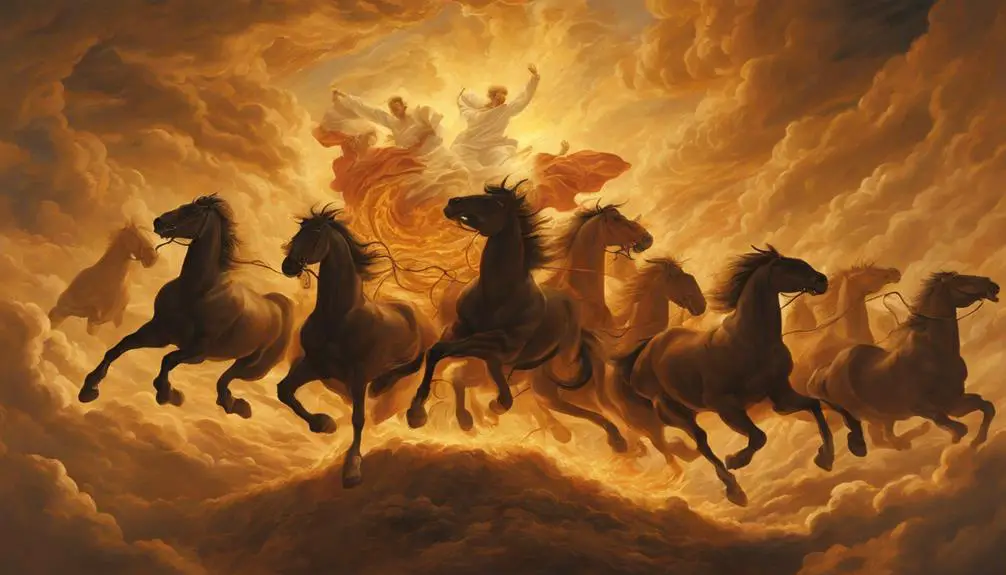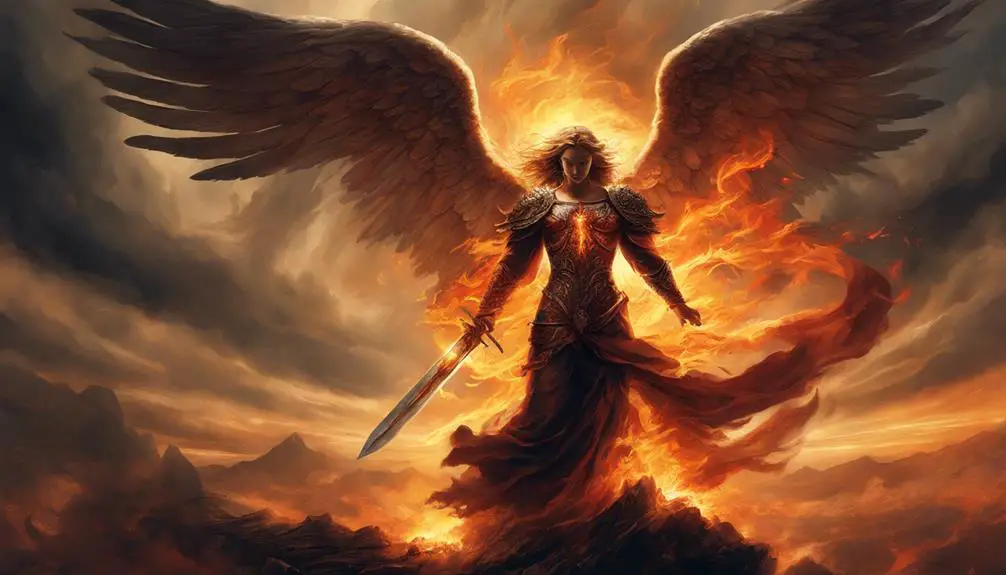Biblical angels of fire captivate with mystery and divine purpose, inviting you to explore their role in celestial narratives and beyond.

Angels of Fire in the Bible
In the Bible, angels herald messages, guide the lost, and execute divine judgment; yet, the enigmatic angels of fire stand apart, captivating and mysterious.
You've encountered them across scriptures, from the cherubim guarding Eden with flaming swords to the seraphim surrounding God's throne in Isaiah's vision.
These celestial beings invite you to explore not just their awe-inspiring appearances but also their profound roles in divine narratives. As you ponder their significance, consider how they illuminate the divine-human relationship and the broader cosmic order.
The journey into understanding these fiery messengers is sure to ignite your curiosity and perhaps, illuminate paths previously unseen.
Key Takeaways
- Fire symbolizes divine presence and purification in biblical narratives involving angels.
- Angels of fire act as God's agents of judgment, protection, and spiritual refinement.
- Their depiction ranges from guardians to messengers, embodying intensity and divine power.
- In Christian theology, they often represent the Holy Spirit's transformative work.
Cherubim: Guardians of Eden

Why did the biblical authors depict cherubim as the guardians of Eden, tasked with blocking access to the Tree of Life after humanity's fall from grace? This portrayal is steeped in the rich tapestry of ancient Near Eastern symbolism, with cherubim artistry playing a crucial role in conveying their divine mandate. Cherubim, often depicted with features amalgamating various creatures, symbolize a bridge between the heavenly and earthly realms. Their placement at Eden's entrance underscores the sanctity and exclusivity of this paradisiacal garden.
Eden's geography, as described in biblical texts, positions it not just as a physical location but as a spiritual ideal, where direct communion with the divine was possible before the fall. Cherubim, by guarding this sacred space, underscore the consequences of human disobedience and the loss of divine proximity. Their role as sentinels serves both as a reminder of what was lost and as a marker of divine mercy, preventing humanity from living in perpetual sin.
The depiction of cherubim in biblical literature, therefore, isn't merely decorative or allegorical. It encapsulates profound theological themes concerning sin, redemption, and the hope for eventual restoration. Through cherubim artistry and the symbolic geography of Eden, the biblical narrative conveys the deep rift between the divine and the human, instigated by sin, yet it also hints at the possibility of reconciliation.
Seraphim: Isaiah's Vision
In the Book of Isaiah, the prophet's encounter with Seraphim introduces a profound vision of celestial worship and divine holiness. You'll find this narrative rich in symbolic imagery, where seraphim characteristics align with themes of purification and sanctity. These celestial beings, described as having six wings, embody the essence of heavenly worship, stationed around the throne of God, continuously proclaiming His glory.
Analyzing their role, it's evident that seraphim aren't mere background figures; their presence and actions serve as a testament to the unwavering holiness that pervades the heavenly realm. Their chant, 'Holy, holy, holy is the Lord of hosts; the whole earth is full of His glory,' encapsulates a central theme of Isaiah's vision: the omnipresence of divine majesty.
Moreover, the interaction between Isaiah and the seraphim—specifically the act of a seraph touching Isaiah's lips with a burning coal—symbolizes purification. This act not only highlights the seraphim's role in facilitating encounters between the divine and the mortal but also underscores the transformative power of heavenly worship.
In essence, Isaiah's vision of seraphim vividly portrays their indispensability in celestial worship, emphasizing their characteristics as bearers of holiness and agents of purification within the divine hierarchy.
Fiery Chariots: Elijah's Ascension

Building on the theme of celestial phenomena within biblical narratives, Elijah's ascension stands out as a pivotal event marked by the appearance of fiery chariots. This moment not only signifies Elijah's departure from the earthly realm but also serves as a powerful instance of prophetic symbolism. The fiery chariots, transcending mere transportation, symbolize divine intervention and the elevation of a prophet beyond mortal limits. This event encapsulates the mystery and majesty of divine communication, positioning Elijah's ascension as a cornerstone of biblical stories involving fire as a divine element.
Aspect |
Significance |
|---|---|
Fiery Chariots |
Symbolize divine presence and intervention. |
Elijah's Ascension |
Represents the transition from earthly to divine. |
Prophetic Symbolism |
Highlights the unique role of prophets in the Bible. |
Divine Intervention |
Illustrates God's direct involvement in human affairs. |
This analysis reveals how Elijah's departure via fiery chariots is replete with meanings that resonate through biblical history. It's not merely about the spectacle but the profound implications it holds for understanding the relationship between the divine and the prophets. As you delve deeper, you'll find that this event is emblematic of the broader narrative of fire as a divine agent within the biblical text, underpinning the sacredness and awe-inspiring power of God's manifestations.
Angel of the Lord: Burning Bush
Transitioning from the narrative of Elijah's fiery ascension, we encounter another profound instance where fire serves as a divine messenger: the encounter of Moses with the burning bush, mediated by the Angel of the Lord. This divine encounter isn't merely a miraculous sign but a pivotal moment in biblical history, symbolizing God's presence and the initiation of Moses' mission to lead the Israelites out of Egypt.
The burning bush, described in the Book of Exodus, is a theophany, an appearance of God in a form comprehensible to humans. Here, the Angel of the Lord appears within the flames of the bush that burns without being consumed, a symbol of God's enduring presence. This encounter isn't just about the miraculous nature of the bush's flames; it's an analytical look into how divine messages are delivered. The Angel of the Lord communicates God's will directly to Moses, setting a precedent for divine-human interaction that emphasizes guidance, mission, and covenant.
Moreover, this event underscores the theme of divine intervention and the critical role of angels as messengers between the divine and the human realms. The burning bush episode serves as a foundational narrative, illustrating how divine encounters can alter the course of human history through direct communication and miraculous signs.
Judgment and Guidance: Biblical Symbolism

The symbolism of judgment and guidance in biblical texts often manifests through vivid narratives and divine interventions, offering profound insights into the moral and spiritual framework that underpins these sacred writings. Divine punishment, as a theme, runs deep, serving not only as a deterrent but also as a transformative force, steering humanity back to righteousness. Through celestial navigation, characters find their way, both literally and metaphorically, guided by divine beings or phenomena. This guidance, often delivered through angels or divine fire, underscores the omnipresence of the divine will in guiding human destiny.
You'll notice that in these narratives, the dual aspects of divine retribution and guidance are inseparable, reflecting the complexity of divine justice. It's not merely about punishing wrongdoing but also about illuminating the path to redemption and enlightenment. This intricate interplay between judgment and guidance is crucial for understanding the biblical perspective on divine intervention. It challenges you to view divine punishment not as an end but as a means to greater moral and spiritual growth, guided by the celestial navigation provided by divine beings. Through this lens, the biblical stories offer not just a historical or religious account, but a timeless reflection on human nature and the possibility of redemption and guidance.
Frequently Asked Questions
How Do Cultural Interpretations of Fire-Associated Angels Differ Across Religions Outside of Christianity and Judaism?
You'll find that across religions, interpretations of fire-associated angels vary significantly. Fire symbolism often represents purification, destruction, and enlightenment.
In interfaith dialogues, analyzing these variances fosters a deeper understanding of each belief system's nuances. While Christianity and Judaism have their perspectives, other faiths like Zoroastrianism view fire as a symbol of divinity and communication with the spiritual realm, shaping their interpretation of such celestial beings differently.
Are There Any Historical or Archaeological Findings That Suggest Early Believers Might Have Created Physical Representations of These Fire-Associated Angels?
As they say, where there's smoke, there's fire. When exploring the possibility of early believers creating physical representations of celestial beings, fire symbolism often ignites curiosity.
Yet, the journey to uncovering artifact authenticity is riddled with challenges. Scholarly analyses reveal few concrete examples, suggesting that while the concept might've inspired artisans, definitive historical or archaeological evidence remains elusive.
This gap underscores the complexity of interpreting ancient beliefs and their material manifestations.
How Have Depictions of Angels of Fire in the Bible Influenced Modern Literature and Art Outside of Religious Texts?
You'll find that modern literature and art, especially within fantasy novels and cinematic depictions, have been significantly influenced by these celestial beings.
This isn't just limited to religious texts; their fiery imagery and symbolism have been creatively adapted to explore themes of divine intervention, morality, and the supernatural.
These adaptations often reflect an intriguing blend of ancient beliefs and contemporary storytelling, showcasing the enduring impact of such figures on creative expression.
Can the Concept of Angels of Fire Be Linked to Any Psychological or Sociological Phenomena Experienced by Communities or Individuals in Ancient Times?
Ironically, you're not alone in feeling the heat when studying ancient phenomena. Fire symbolism, deeply embedded in human cultures, evokes a sense of psychological resilience in communities and individuals facing adversity.
This concept mirrors the strength found in overcoming challenges, akin to walking through fire unscathed. Analyzing this through a scholarly lens, it's clear that the symbolic use of fire in ancient times had profound psychological and sociological impacts, shaping resilience and communal bonds.
How Do Contemporary Theologians Reconcile the Ancient Imagery of Fire-Bearing Angels With Modern Understandings of Angelology and Spirituality?
You're exploring how theologians today integrate ancient imagery into current spiritual understandings. They delve into metaphysical interpretations and theological symbolism to bridge these concepts.
By analyzing the roles and representations of celestial beings, you're uncovering how ancient symbols, like fire, are reinterpreted in modern theology.
This approach reveals a continuity and evolution in spiritual thought, showing how historical images are adapted to fit contemporary spiritual landscapes.
Conclusion
In conclusion, the portrayal of fiery angels across biblical narratives underscores their roles in divine intervention, guidance, and judgment.
Interestingly, among the various depictions, Seraphim stand out with their six wings, a detail mentioned only twice in the entire Bible, emphasizing the rarity and significance of their divine missions.
This statistic mirrors the exceptional nature of angelic interventions in biblical stories, highlighting their pivotal roles in conveying divine will and guiding human destiny in a complex theological tapestry.



Sign up